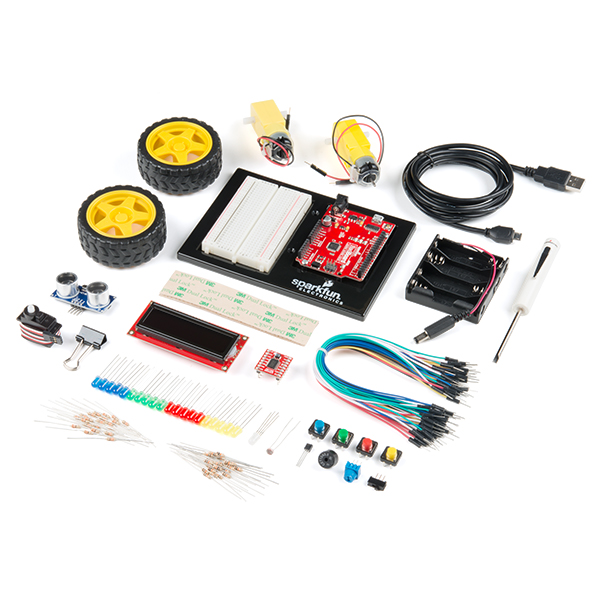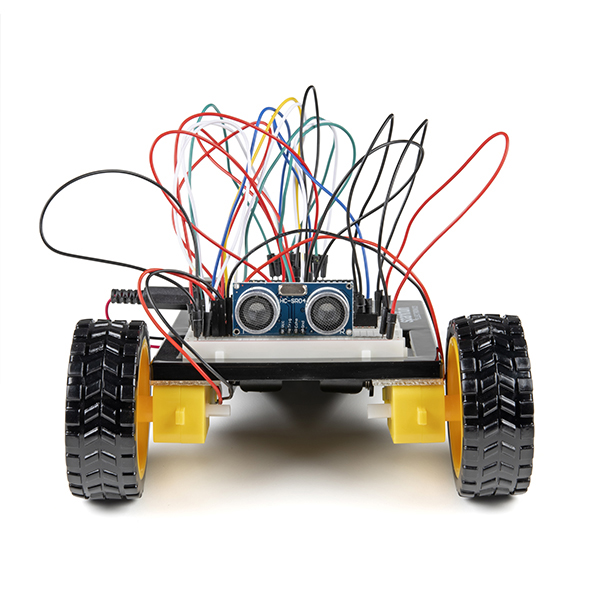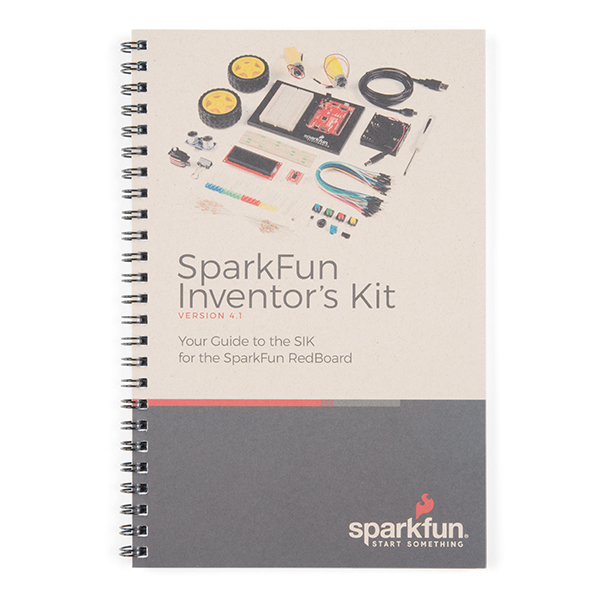SparkFun Inventor's Kit - v4.1
The SparkFun Inventor's Kit (SIK) is a great way to get started with programming and hardware interaction with the Arduino programming language. The SIK includes everything you need to complete five overarching projects consisting of 16 interconnected circuits that teach everything from blinking an LED to reading sensors. The culminating project is your very own autonomous robot! No previous programming or electronics experience is required to use this kit.
The full-color, spiral-bound SIK guidebook (included) contains step-by-step instructions with circuit diagrams and hookup tables for building each project and circuit with the included parts. Full example code is provided, new concepts and components are explained at point of use, and troubleshooting tips offer assistance if something goes wrong.
The kit does not require any soldering and is recommended for beginners ages 10 and up who are looking for an Arduino starter kit. For SIK version 4.1 we took an entirely different approach to teaching embedded electronics. In previous versions of the SIK, each circuit focused on introducing a new piece of technology. With SIK v4.1, components are introduced in the context of the circuit you are building, and each circuit builds upon the last, leading up to a project that incorporates all of the components and concepts introduced throughout the guide. With new parts and a completely new strategy, even if you've used the SIK before, you're in for a brand-new experience!
The SIK V4.1 includes the Redboard Qwiic which allows you to expand into the SparkFun Qwiic ecosystem after you have become proficient with the SIK circuits. The SparkFun Qwiic Connect System is an ecosystem of I2C sensors, actuators, shields and cables that make prototyping faster and less prone to error. All Qwiic-enabled boards use a common 1mm pitch, 4-pin JST connector. This reduces the amount of required PCB space, and polarized connections mean you can’t hook it up wrong. With the addition of the SparkFun RedBoard Qwiic, you will need to download a new driver install that is different from the original SparkFun RedBoard.
- SparkFun RedBoard Qwiic
- Arduino and Breadboard Holder
- SparkFun Inventor's Kit Guidebook
- White Solderless Breadboard
- Carrying Case
- SparkFun Mini Screwdriver
- 16x2 White-on-Black LCD (with headers)
- SparkFun Motor Driver (with Headers)
- Pair of Rubber Wheels
- Pair of Hobby Gearmotors
- Small Servo
- Ultrasonic Distance Sensor
- TMP36 Temp Sensor
- 6' USB micro-B Cable
- Jumper Wires
- Photocell
- Tricolor LED
- Red, Blue, Yellow and Green LEDs
- Red, Blue, Yellow and Green Tactile Buttons
- 10K Trimpot
- Mini Power Switch
- Piezo Speaker
- AA Battery Holder
- 330 and 10K Resistors
- Binder Clip
- Dual-Lock™ Fastener
- SIK Printed Guidebook (PDF, Download File: 31.9MB)
- SIK Print Guide Errata (v4.1)
- Online Experiment Guide
- RedBoard Qwiic Driver Install
- SIK Info Page
- Dimensional Drawing
- SIK Case Insert Files
- Project 1: Light
- Circuit 1A: Blinking an LED
- Circuit 1B: Potentiometer
- Circuit 1C: Photoresistor
- Circuit 1D: RGB Night-Light
- Project 2: Sound
- Circuit 2A: Buzzer
- Circuit 2B: Digital Trumpet
- Circuit 2C: "Simon Says" Game
- Project 3: Motion
- Circuit 3A: Servo Motors
- Circuit 3B: Distance Sensor
- Circuit 3C: Motion Alarm
- Project 4: Display
- Circuit 4A: LCD "Hello, World!"
- Circuit 4B: Temperature Sensor
- Circuit 4C: "DIY Who Am I?" Game
- Project 5: Robot
- Circuit 5A: Motor Basics
- Circuit 5B: Remote-Controlled Robot
- Circuit 5C: Autonomous Robot
SparkFun Inventor's Kit - v4.1 Product Help and Resources
Light-Seeking Robot
November 28, 2017
We use parts from the SparkFun Inventor's Kit v4.0 to create a light-seeking robot that mimics the behavior of single-celled organisms.
Clap On Lamp
November 28, 2017
Modify a simple desk lamp to respond to a double clap (or other sharp noise) using parts from the SparkFun Inventor's Kit v4.0.
How to Install CH340 Drivers
August 6, 2019
How to install CH340 drivers (if you need them) on Windows, Mac OS X, and Linux.
Endless Runner Game
November 28, 2017
We make a simple side-scrolling endless runner game using parts from the SparkFun Inventor's Kit v4.0.
Measuring Internal Resistance of Batteries
May 5, 2016
Classroom STEM activity that has students build a battery from a lemon, measure the open and closed circuit voltages, and determine the battery's internal resistance.
Basic LED Animations for Beginners (Arduino)
December 3, 2019
Let's have some fun with LEDs! We'll explore LEDs once again with the SparkFun RedBoard Qwiic, making cool effects, and putting those effects to work using a sensor.
SparkFun Inventor's Kit Experiment Guide - v4.1
August 8, 2019
The SparkFun Inventor's Kit (SIK) Experiment Guide contains all of the information needed to build all five projects, encompassing 16 circuits, in the latest version of the kit, v4.1.2 and v4.1.
Basic Character LCD Hookup Guide
May 28, 2019
Liquid crystal displays (LCDs) are a great way to output a string of words or sensor data to a display for visual feedback. In this tutorial, we'll learn about LCDs, how to print a string of words to a 16x2 basic character LCD and create custom characters.
Core Skill: Robotics
This skill concerns mechanical and robotics knowledge. You may need to know how mechanical parts interact, how motors work, or how to use motor drivers and controllers.
Skill Level: Noob - You will be required to put together a robotics kit. Necessary parts are included and steps will be easy to follow. You also might encounter basic robotics components like bearings, mounts, or other hardware and need a general idea of how it goes together.
See all skill levels
Core Skill: DIY
Whether it's for assembling a kit, hacking an enclosure, or creating your own parts; the DIY skill is all about knowing how to use tools and the techniques associated with them.
Skill Level: Noob - Basic assembly is required. You may need to provide your own basic tools like a screwdriver, hammer or scissors. Power tools or custom parts are not required. Instructions will be included and easy to follow. Sewing may be required, but only with included patterns.
See all skill levels
Core Skill: Programming
If a board needs code or communicates somehow, you're going to need to know how to program or interface with it. The programming skill is all about communication and code.
Skill Level: Rookie - You will need a better fundamental understand of what code is, and how it works. You will be using beginner-level software and development tools like Arduino. You will be dealing directly with code, but numerous examples and libraries are available. Sensors or shields will communicate with serial or TTL.
See all skill levels
Core Skill: Electrical Prototyping
If it requires power, you need to know how much, what all the pins do, and how to hook it up. You may need to reference datasheets, schematics, and know the ins and outs of electronics.
Skill Level: Rookie - You may be required to know a bit more about the component, such as orientation, or how to hook it up, in addition to power requirements. You will need to understand polarized components.
See all skill levels
Comments
Looking for answers to technical questions?
We welcome your comments and suggestions below. However, if you are looking for solutions to technical questions please see our Technical Assistance page.
Customer Reviews
4.7 out of 5
Based on 13 ratings:
1 of 1 found this helpful:
Pretty good!
Easy to use. All you can ever need in a kit. Got it delivered the next day.
Great starter kit!
Great "sampler" of so many types of sensors and controls. Instructions are clear and repeatable. I have some background skills in electronics, radios, computers and programming, but this kit assumes nothing. I am learning a lot, even though some of it may be familiar. This is my platform for launching many future projects with my kids as their interest grows. Thank you!
Good project kit for a beginner
The LED projects are cool. Ready to start project 2. It can be very confusing dealing with the wires, but it's fun to see what comes out in the end. Tryg. 9 yrs old
Great starter kit
Great beginner kit. Easy to follow online guide as well as a book included in the box yet still challenging enough to entertain my 11 year old for several hours. The kit is well packaged though it would be great to have dividers/compartments in the box for storing the parts after removing the packaging.
Great kit and even better manual / instructions
I'm a bit ambitious and have been working through projects with my 8 year old. Some of the concepts are a bit advanced for that age, but I love having the detailed "teachers" manual and all of the code samples available right in the Arduino IDE. I think this has been a great introduction on how to interact with the "real" world using code.
Great Kit for Learning
The Inventor's Kit is a great beginner's kit to learn the basics of electronics and Arduino coding.
Top Quality Components and Project Guide
This is a top quality kit with excellent components and a well written and illustrated guide. Each project builds on lessons learned in previous ones. No soldering required. The programming is all provided, but the guide encourages modifications to the programs for fuller understanding. All in all an impressive kit!
Loved it!!!
A great kit to introduce many concepts and functions. Loved every project. Now I’m using the parts to make bigger and better projects!
Great for beginners
I'm brand new to arduino and this kit is making the entry very easy to digest and friendly. Some of the components are pretty low quality and the setup needs to be occasionally adjusted, but if you have some patience and common sense, it won't be an issue. Strongly recommend.
Great manual! Higher quality components than I expected, but also? The manual is very high quality.
So, here's what I have to compare this kit to: The Make: Electronics kit, which unfortunately took a very long time to get to me, coloring my perception of their kit, plus? They didn't manage to get the book I'm SURE I ordered with the kit, to me, in addition to the shipping delay. Now, the delay wasn't their fault, they say Covid-19 shut down their warehouse. Why am I mentioning all of this? Because I'm brand new to electronics, and kits like this, except for some Radio Shack boxed kits using springs to connect circuits, and so having the BOOK is a big deal for me, because I like having the book, and yeah, yeah, I can and do go online, but this kit from Spark Fun? GREAT BOOK! And it's spiral bound, so it lays flat while I try to follow along. I like the code, and the whole thing has been working flawlessly so far: I'm halfway through the book. :) Any problems I've had have been user error, and I'm really enjoying the projects and the quality of the included components.
Great kit!!!
I loved this kit. I had some time during Christmas vacation and ran through everything. Excellent manual with great illustrations. It was a good selection of circuits. The comments in the code complimented what was in the manual. Neat stuff!!!
Overall pretty good
Pros: Activities are well planned, simple enough for a younger child to use with the help from an adult (my son is 10) but with the versatility to engage older ones as well. Website has a lot of additional resources which really helps. Overall would definitely recommend.
Cons: Our inventor's kit had a lot of plastic shavings inside that made quite a mess when unpacking. Some of the things in the manual are outdated which was a little annoying but luckily plenty of support online.
Thank you for your feedback here. Sorry about the extra loose material and old manual there. I will provide this information along. Please feel free to reach out to Support@SparkFun.com should you need anything else.





Hello, here is a video guide that I have worked on for this kit.
https://www.youtube.com/watch?v=K0MTLJuJIWM&list=PL-MpQVvC1wogAPJ7unc5m7LuJ7gsTGYr8
Student-friendly
Youtube Channel: Create with Cobian
The Sparkfun Inventor's Kit has been in the "backorder" state for a few months. Has the product been discontinued? Is there a new version in the works? (Perhaps with lots of QWIIC modules instead of discrete parts?)